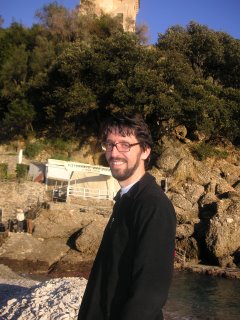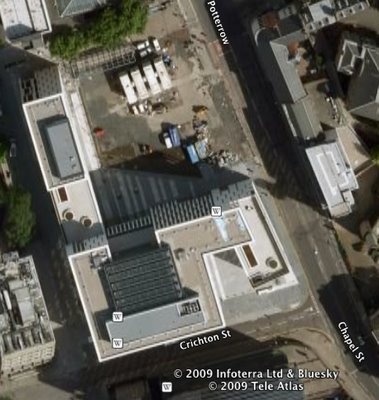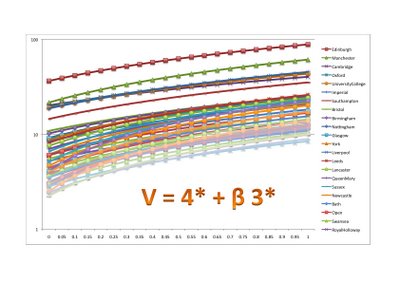Winter Wonderland: ww.inf.ed.ac.uk
 Today we had a snowball fight. See picasa for more images of the roof garden in the snow.
Today we had a snowball fight. See picasa for more images of the roof garden in the snow.Labels: edinburgh, forum, informatics, snow, winter
Public News and Announcements Blog from the School of Informatics at the University of Edinburgh.
 Today we had a snowball fight. See picasa for more images of the roof garden in the snow.
Today we had a snowball fight. See picasa for more images of the roof garden in the snow.Labels: edinburgh, forum, informatics, snow, winter

I am delighted to announce that Dr Guido Sanguinetti will join the School of Informatics on 1st August, as a SICSA lecturer.
Guido received his MSc (Laurea) in Physics in his native Genova, and then pursued a D.Phil. in Mathematics at the University of Oxford, working on algebraic and differential geometric methods to solve nonlinear differential equations.
After two years as a professional musician, he returned to research in 2004 as a postdoc and then a lecturer in Computer Science in Sheffield. His main research interests lie in reverse engineering dynamical systems governed by sets of (stochastic) differential equations, with a particular focus on applications in systems biology.
Guido will take a leave of absence to allow him to complete some projects at Sheffield, but he plans to make several extended visits to Edinburgh before moving to Scotland in 2010.
Labels: appointment, edinburgh, informatics, sanguinetti, sheffield, sicsa

I am delighted to announce the appointment of Dr. Charles Sutton to a SICSA lecturership in the School of Informatics.
Charles has been a postdoctoral researcher at the University of California, Berkeley, since 2007. His recent work has aimed at new statistical machine learning methods designed to aid the management of large-scale computer systems. In particular, he has developed methods for performance modeling that are rooted in machine learning, applying them to the control, visualization, and diagnosis of distributed Web applications. More generally, his research interests include machine learning, graphical models, approximate inference, structured prediction, natural language processing, and the application of machine learning methods to computer systems. Charles received his PhD from the University of Massachusetts Amherst in 2008. His thesis work concerned efficient training methods for conditional random fields, with applications in natural language processing.
Labels: appointment, berkeley, charles sutton, edinburgh, informatics, machine learning

I am delighted to announce that Dr Iain Murray will join the School of Informatics on 1st August, as a SICSA lecturer and a member of the Institute of Adaptive and Neural Computation.
Iain received MA and MSci degrees in Natural Sciences (Physics) from the University of Cambridge before obtaining a PhD from the Gatsby Computational Neuroscience Unit at University College London. His thesis introduced a range of new 'Markov chain Monte Carlo' algorithms for solving integrals in hard statistical inference problems. While at Gatsby Iain also developed strong interests in probabilistic modelling and efficient algorithms for solving inference problems.
Partly supported by a Canadian Commonwealth Research Fellowship, Iain moved to Toronto in 2007 and joined the Machine Learning group there as a postdoctoral fellow. He has continued to expand the applicability of Markov chain Monte Carlo methods for statistical applications, such as the evaluation of large-scale probabilistic models. Iain has also formed collaborations to apply and extend hierarchical Bayesian methods. Recent application areas include understanding human perception and inferring celestial dynamics.
Iain will take a leave of absence to allow him to complete his Fellowship in Toronto, but he plans to make several extended visits to Edinburgh before moving to Scotland in 2010.
Labels: appointment, edinburgh, gatsby, iain murray, informatics, monte carlo
Congratulations to Peter Buneman on his election as a Fellow of the Royal Society.
A total of eleven past and present distinguished Edinburgh informaticians have been elected to this fellowship. Of these, Peter Buneman, Robin Milner and Gordon Plotkin are current members of the School.
Peter Buneman is distinguished for his advances in uniting programming languages and databases. On the theoretical side this has involved new results in types, monads and structural recursion including (with his student Ohori) type inference for record types, and (with Tannen et al) results that demonstrated a tight connection between monad-based languages and those based on the predicate calculus. On the application side, he used these techniques to demonstrate that -- contrary to an assertion by the US Department of Energy -- queries on existing non-relational genomic databases could be directly evaluated; fruitful collaboration with biologists ensued.
This research on databases and languages carries over into his recent study of the principles of semistructured or "web-like" data of which he is a leading proponent, and co-author of the first text book in this new field. Another recent concern is with the provenance of data on the Web, where data is continually copied and transformed. Already, with Khanna et al. he has built an efficient archiving system for scientific databases; more fundamentally, he seeks a formal basis for tracing provenance.
In addition to his work in databases, Buneman's early work on mathematical phylogeny underlies most modern phylogenetic reconstruction techniques.
Labels: buneman, edinburgh, FRS, informatics
I am delighted to announce that Robin Milner is returning to the University of Edinburgh, part-time. He will be a SICSA Advanced Research Fellow and will hold the Chair of Computer Science.
Robin Milner graduated from Cambridge in 1958. After short posts he joined the University of Edinburgh in 1973, where he co-founded the Laboratory for Foundation of Computer Science in 1986. He was elected Fellow of the Royal Society in 1988, and in 1991 won the ACM's A.M. Turing Award. He joined Cambridge University in 1995, headed the Computer Laboratory there for four years, and retired in 2001. His research achievements (often joint) include: the system LCF, a model for many later systems for interactive reasoning; Standard ML, an industry-scale but rigorously based programming language; the Calculus of Communicating Systems (CCS); the Pi Calculus.
Currently he works on Bigraphs, a topographical model which aims to provide a theoretical foundation for mobile interactive systems. Cambridge University Press has just published The Space and Motion of Communicating Agents, Robin's book on this area.
Robin will be giving a short course on bigraphs in Edinburgh on May 13th and 14th 2009. So that we can keep track of numbers, please sign up for the course at http://milner-bigraphs.eventbrite.com (password is milner).
Labels: appointment, bigraphs, computation, edinburgh, forum, informatics, milner, mobility, model, sicsa, ubiquitous

Google has updated Google Earth with new images for Edinburgh Southside, dated 21 July 2008.
Open the title link with Google Earth to see the George Square masterplan superimposed on the Forum.
Labels: earth, edinburgh, forum, google, informatics, potterrow, university

HEFCE has published preliminary results of the RAE.
These comprise tabulated overall quality profiles per unit of assessment (UoA) and per institution. Each quality profile presents the proportions, rounded to 5 per cent, of research activity in each submission judged to have met each of the quality levels from 4* to unclassified. Alongside the quality profile for each submission, HEFCE publish the full-time equivalent (FTE) number of Category A staff included in the submission.
The highest, 4* grade is awarded for work that is world-leading; 3* is for internationally excellent, and 2* for internationally recognised research.
Taking the profile percentages of the FTE staff number gives a research volume profile for each submission.
These results confirm that the University of Edinburgh is, once again, the strongest in the UK for research in Informatics and Computer Science.
Informatics at Edinburgh delivers more world-leading (4*) research than anyone else — 69% more than our nearest competitor.
We contribute 10% of the UK's world-leading research in this UoA.
We deliver more internationally-excellent (3*) or world-leading (4*) research than anyone else — 44% more than our nearest competitor. Edinburgh contributes more research that is at least internationally excellent than Oxbridge.
Overall, ours is the largest research grouping in the UK — again, 44% larger than our nearest competitor.
All of our research is internationally recognised, or better (2*, 3* or 4*) — and we submitted every eligible member of staff.
The use of grade profiles means that there is no single ranking as a result of this RAE.
The detailed formulae for research funding based on the RAE will not be announced by funding councils for several months. However, future research funding is expected to be based on a weighted sum over the RAE volume profile.
For any score given as a weighted sum S = α 4* + β 3* + γ 2* + δ 1*, where &alpha > 0 and α ≥ β ≥ γ ≥ δ ≥ 0, Edinburgh scores top in the UK.

Our volume of world-leading and internationally excellent research (88.6 FTE) exceeds our entire submission to RAE 2001 (80.2 FTE). In addition, we have recently made half a dozen outstanding new appointments, not included in this assessment, that further increase our research excellence and capacity. We have also recently improved our environment by moving into the Informatics Forum — acclaimed as the best building in Scotland. This building, designed for interaction, brings an eclectic multidisciplinary collection of over 500 researchers in Informatics and Computer Science together, under one roof.
Edinburgh has the UK's strongest research group in Linguistics, with more world-class (4*) research in Linguistics (10.8 FTE) than any two other submissions combined. Through the Human Communication Research Centre (HCRC) and the Centre for Speech Technology Research (CSTR), we work closely with these colleagues in the areas of Speech and Language Processing, Computational Linguistics and Cognitive Science.
The Scottish Informatics and Computer Science Alliance (SICSA) brings together internationally excellent research from across Scotland, to double the University of Edinburgh's 3* + 4* volume. This critical mass of excellence makes Scotland a match for any leading centre of Informatics and Computer Science, worldwide.
SICSA is actively recruiting, and plans to complete appointments to some 30 new posts by the end of 2010. Our policy is to recruit internationally, to make outstanding appointments that raise our research quality, and further strengthen Scotland's profile in Informatics and Computer Science.
Eighty-one submissions were made to UoA 23. The top ten (by 4* volume) account for over 50% of the UK's world-leading research in this UoA.
Manchester is our nearest competitor. Cambridge, Oxford, University College, and Imperial College — almost indistinguishable from one another — come next, followed by Southampton; Bristol, Birmingham and Nottingham complete the top ten.
The abscissa is a parameter β
The ordinate (plotted on log scale) is V = 4* + β 3*
The point is that whatever reasonable combination of 4* and 3* volume you choose to take, Edinburgh comes out tops.
The use of a log scale makes it easier to compare relative sizes. For example, the gap between Cambridge and Manchester at the right-hand end of the graph signifies that Manchester has roughly 50% more 3* + 4* volume than Cambridge. A slightly larger gap at the left-hand end between Manchester and Edinburgh signifies that Edinburgh has more than 50% more 4* volume than Manchester.
Labels: 2008, computer science, computing, edinburgh, informatics, linguistics, RAE, Scotland, sicsa, uk
TPR is an external, quinquennial review of our undergraduate teaching. We were reviewed on 24th and 25th November.
External review team: Gilles Dowek(Paris), Nigel Shadbolt(Soton), Martyn Thomas(Praxis), Mads Tofte(ITU Denmark)
The reviewers gave immediate informal feedback:
The formal report is expected early next year,
Many thanks to the reviewers for their time, effort and advice.
Labels: edinburgh, informatics, review, teaching, tpr
So, the Forum is Number Two Crichton Street. Appleton Tower (11 Crichton Street) is Number Three.
We're now working on Number One - inSpace, our workshop, gallery and public engagement space for Informatics and Creativity, being fitted out for opening next year, on the corner with Potterrow.
Guardian critics pick this autumn's unmissable shows
Architecture
Informatics Forum, University of Edinburgh*
Autumn at the University of Edinburgh will see the opening of this wonderful research centre designed for a faculty that brings together biology, neurology, linguistics and art. It looks like a see-through Rubik's Cube.
Don't miss it on Open Doors day 27th September
What is BREEAM?
BREEAM is the world's most widely used environmental assessment method for buildings.
Informatics@Edinburgh - number one in research, excellent in teaching - now also environmentally excellent!
Edinburgh University's School of Informatics is already the top computing science school in the UK and one of the leading four of its kind in the world.
Hume famously said, "The spirit of the age affects all the arts". In the age of information, informatics affects the arts, the sciences, and the humanities.
Labels: breeam, edinburgh, excellent, forum, herald, hume, informatics, news, scotsman, THES

Over the past 20 years, a significant change has occurred in AI research. Many researchers have moved from the early AI paradigm of writing programs for ill-defined problems to writing solvers for well-defined mathematical models such as Constraint Satisfaction Problems, Strips Planning, SAT, Bayesian Networks and Partially Observable Markov Decision Processes.
Solvers are programs that take a compact description of a particular model instance (a planning problem, a CSP instance, and so on) and automatically compute its solution. Unlike the early AI programs, these are general-purpose in the sense that they are not designed to deal with a particular problem but with a large, in fact, infinite collection of problems.
This presents a crisp computational challenge: how to make these solvers scale-up to large and interesting problems given that all these models are intractable in the worst case. Work in these areas has uncovered techniques that accomplish this by automatically recognizing and exploiting the structure of the problem at hand.
My goal in this talk is to articulate this research agenda, to go over some of ideas that underlie these techniques, and to show the relevance of these models and techniques to those interested in models of general intelligence and human cognition.

Hector Geffner is a Distinguished Visiting Researcher in the School of Informatics, and a recently elected Fellow of AAAI. He was a student of Judea Pearl, and won the ACM Distinguished Dissertation Award in 1990. Hector has worked at IBM (Yorktown Heights, NY, USA) and the Universidad Simon Bolivar (Caracas, Venezuela). He is currently a researcher at the Institucion Catalana de Recerca i Estudis Avançats (ICREA) and a professor at the Departamento de Tecnologia, Universitat Pompeu Fabra, where he heads the Artificial Intelligence Group.
Labels: artificial intelligence, distinguished, edinburgh, geffner, informatics, lecture

Abstract Technical and infrastructural developments are coming together to provide a nurturing environment for creating, studying, and fielding valuable machine learning and reasoning systems. Numerous efforts have been stimulated by the increasing availability of data for studies in learning and adaptation. The data-rich environment poses interesting new challenges and opportunities, and frames new theoretical and practical work. I will present several illustrative research efforts that highlight challenges and directions with the streaming of machine intelligence into the daily lives of people. I will focus thematically on opportunities for harnessing machine learning and reasoning to better understand and support people, and the critical role of methods for representing and reasoning about human intentions, preferences, and initiative.
Biography Eric is a Principal Researcher and Research Area Manager at Microsoft Research. His interests span core challenges in machine reasoning and learning, search and information retrieval, and human-computer interaction. He has served as Associate Editor of the Journal of the ACM, as Chair of the Association for Uncertainty and Artificial Intelligence (AUAI), and on the DARPA Information Science and Technology Study Group (ISAT). He has been elected Councilor and Fellow of the American Association for Artificial Intelligence (AAAI) and is currently serving as President of the organization. He received his PhD and MD degrees at Stanford University.
Labels: distinguished, edinburgh, horvitz, informatics, lecture, privacy


The Google Europe Anita Borg Memorial Scholarships were awarded for the first time in Europe in 2007. Two students from Informatics@Edinburgh received awards.
180 students from 93 different universities across Europe applied. Initial selection criteria included academic performance, accomplishments within the science and technology community, letters of recommendation, and answers to four short essay questions. After two rounds of review, the committee selected 31 finalists, who were then interviewed by members of the review committee.
Twelve outstanding young women, including Sabrina Pei-Yun Hsueh, received a €5,000 Scholarship for the 2007/2008 academic year.
The remaining 19 finalists, including Vera Demberg, received a €1,000 award.
Multiple scholarships will be awarded in 2008 based on the strength of candidates' academic background and demonstrated leadership. The competition is open to women studying Computer Science, Computer Engineering, Informatics, or a closely related technical field, with an excellent academic record (e.g. a First Class Honours degree). European citizens, permanent residents, and international students, who will enter the final year of a Bachelor’s degree in 2008/2009, or be enrolled in a Master’s or PhD programme (or equivalent), at any University in Europe, are eligible to apply.
Labels: anita borg, bsc, edinburgh, google, informatics, msc, phd, scholarship
From 27-29th June, we will be welcoming the Edinburgh Computer History Project, a group of former staff, students and associates, Edinburgh pioneers from the early days of computing, back to Edinburgh for a reunion.
Following on from our graduation ceremony and celebrations on June 26th, a series of events, incorporating our annual Informatics Jamboree and Milner Lecture, will take place from June 27 - 29.
All those with an interest, and particularly those who have contributed to the history of computing at Edinburgh, are warmly invited to attend — there is a registration fee of £12.50. Please register online.
Update Sunday 17th June The reunion dinner on the 28th is now full to capacity. All other events are still open and you can still register (then if we have any cancellations for dinner, we can allocate those places to the people who register first).
Visit the Edinburgh Computer History Project forum for more information on the project.
Those planning to attend should download an information pack. If you have any further questions about the reunion please contact our Alumni Relations Officer.
Those attending may also be interested in the Enlightenment Lecture, Is science showing that we don't have free will? to be delivered by by Daniel Dennett at
Labels: alumni, computer, echp, edinburgh, history, informatics, Michie, milner, reunion